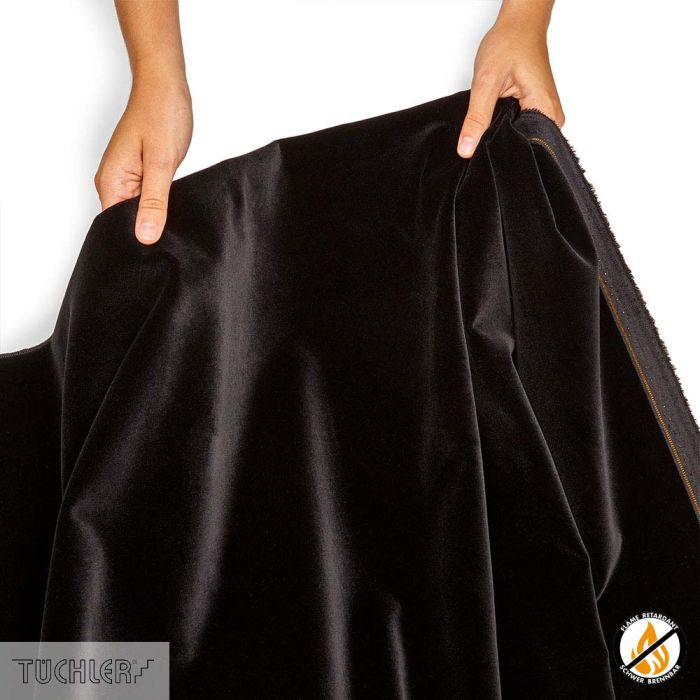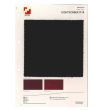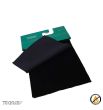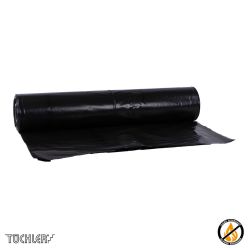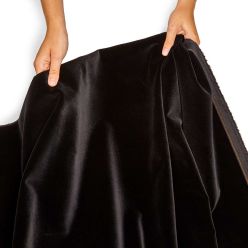Stage velour LIGHTSORBER D18
Velvet
Stage velour LIGHTSORBER D18
 Made in EU
Made in EU
The stage velour lightSORBER D18 is the reference velour for the 600g/m² class of stage velours. Its special lightSORBER construction and lightSORBER colouring make it top of the class where a colour-neutral and deep black is concerned.
Due to its acoustic properties - rated sound absorption coefficient α(w) is 0.35 and therefore absorbs hardly any sound energy - the stage velour lightSORBER D18 is particularly suitable for use on opera stages.
The body colour of your stage curtains is the motor and your light the fuel for your colour perception, so to speak.
For perfect function, motor and fuel must be compatible.
This is particularly true of stage curtains, because black is a special “burden” on the human eye. The “fuel” light has changed significantly due to LED technology in recent years. As a result, many a black surface started to run “unevenly” and appears light, silvery, greyish, crumpled - certainly not quite as black as it used to.
A combustion motor needs fossil fuels, an electric motor electricity to function. Only a hybrid motor can handle both.
The TÜCHLER lightSORBER velours are such hybrid motors for black: they take the blue-heavy spectral properties of LED light just as much into account as the red-heavy spectrum of classic Tungsten lights.
lightSORBER velours thus accommodates the simultaneous use of various sources of light.
In a nutshell: TÜCHLER lightSORBER velours deliver the most colour-neutral deep black for all types of light on the market.
Technische Details:
- flame-retardant; EN 13501 C-s2-d0, EN 13773-C1
- flame-retardant according to GOST R 50810-95
- 100% cotton
- width 150 cm
- 600 g/m²
- appr. 30lm rolls
- αw: 0,35 to 0,6
- Sound absorber class: C to D
% REMAINING STOCK % SALE %
Please note: Remaining stock items are reserved in the shopping cart for 24 hours.
| ArtNr | Name | Color/Size/Deco | Quantity | Price Offer | Charge | Quality | Note | |
|---|---|---|---|---|---|---|---|---|
| 1003212 | Stage velour LIGHTSORBER D18 | 0371 WEINROT/WINE-RE 150CM / LFM | 9,65 lm | 02040813010/282512/09 | 1st choice | |||
| 1003212 | Stage velour LIGHTSORBER D18 | THEATERSCHWARZ 1 150CM / LFM | 5,40 lm | 02040534020/282423/07 | 1st choice | |||
| 1003212 | Stage velour LIGHTSORBER D18 | THEATERSCHWARZ 1 150CM / LFM | 5,90 lm | 02040534020/282424/11 | 1st choice | |||
| 1003212 | Stage velour LIGHTSORBER D18 | THEATERSCHWARZ 1 150CM / LFM | 5,96 lm | 02038908010/279037/09 | 1st choice | |||
| 1003212 | Stage velour LIGHTSORBER D18 | THEATERSCHWARZ 1 150CM / LFM | 7,50 lm | 02039044010/279192/01 | 1st choice | |||
| 1003212 | Stage velour LIGHTSORBER D18 | THEATERSCHWARZ 1 150CM / LFM | 8,40 lm | 0204010801/2803600/02 | 1st choice | |||
| 1003212 | Stage velour LIGHTSORBER D18 | THEATERSCHWARZ 1 150CM / LFM | 8,50 lm | 0204010801/2802170/06 | 1st choice | |||
| 1003212 | Stage velour LIGHTSORBER D18 | THEATERSCHWARZ 1 150CM / LFM | 8,60 lm | 0204010801/2803600/03 | 1st choice |
Please note that remaining stock may be slightly shorter or longer than indicated. Smaller quantities of up to 10% of the target length are deemed to be compensated by the remaining stock discount. If there are major deviations in individual cases, you can return the uncut piece to and receive a refund of the purchase price. As with normal pieces, cut pieces are excluded from exchange or return. Please note that remaining stock is excluded from return for reasons other than the above-mentioned quantity deviation or justified quality defects.
handy Accessories + Supplies
usage instructions and warnings for flame resistant cotton fabrics!
Valid from 1 January 2014
Unless expressly noted otherwise, cotton fabrics marked flame retardant (hardly flammable) are treated with a semi-permanent flame retardant. This means that as long as the material is not soaked or washed, the flame retardant characteristics will persist. Therefore, soaking or washing will cause the loss of fire retardant characteristics. Flame retardant characteristics can be maintained through professional dry cleaning without stain removing agents and a low proportion of water. It is mandatory to carry out tests after dry cleaning.
usage instructions and warnings for silks!
valid from 1 January 2014
1. Packaging and acceptance of stage velvets sold by the metre:
All stage velvets sold by the metre are carefully packed, hanging in transport boxes. In general, the transport boxes are shipped lashed down horizontally on pallets.
WARNING: Upon acceptance, the purchaser must check that the transport boxes are delivered lashed down horizontally on pallets. If this is not the case, he must note this on the shipping documents. If the transport boxes arrive loosely (without being lashed down), it is probable that the boxes were transported or stored vertically. This leads to irreversible damage to the stage velvets. Noticeable signs are zebra /harmonica-shaped creases and pressure points which repeat in an arch shape along one or both edges. The shipper/transport company is responsible for such unambiguous transport damages.
However, the purchaser can only claim for this if he immediately notes the loose delivery of the boxes in the shipping documents upon delivery or completely refuses acceptance. Even if there is no visible damage on the outside of the boxes, it is possible that damage has occurred to the product! For all further matters, item 10 of the Tüchler Bühnen- & Textiltechnik GmbH General Terms and Conditions applies unmodified.
2. Colour accuracy and reflective stripes
2.1 Despite due care in the dyeing process, it is not possible to completely avoid minor colour deviations due to technical grounds. This also applies to within one and the same colour portion. Slight colour deviations, especially those which are not or hardly noticeable in velvets used to make curtains with folds, do not constitute a reduction in the quality of the stage velvet.
2.2 The angle of the pile can vary within a roll of velvet. This is due to technical grounds when winding the velvet, and causes a variation in reflection of the incident light. This can create the false impression that the colour is fading (=slow or continuous change of colour within a roll). This does not constitute a reduction in quality.
2.3 From the moment stage velvets are packaged, they are subject to a relaxation process caused by the material’s characteristics. This leads to micro-movements. As stage velvet can only move in one direction, in reaction to the pile on the roll, the rolls lose their circular shape. These non-circular rolls often show a clearly noticeable edge, which creates the impression that the stage velvet was not wound properly. The pile angle on this edge often contrasts significantly with the rest of the velvet roll which has remained round. This regularly causes very noticeable, but reversible reflective stripes. These reflective stripes do not constitute a reduction in quality.
2.4 Dependent on room conditions, the pile will realign itself after some time. The consistency and luxuriance of the velvet is only fully re-established after this takes place. This process can often take weeks. If reflective stripes or colour fading due to reflection persist despite a long recovery period, lightly steaming and softly brushing in the direction of the pile can shorten or support the pile recovery process. Please note: This process can take even longer in centrally heated, hot rooms lacking humidity.
3. Using velvet in assembly
3.1 The pile for velvet curtains is longitudinal. Therefore, it can either be assembled pile “up” or pile “down”. If the customer does not expressly ask for a specific pile direction, Tüchler finishes curtains pile up. This means that the colour appears richer and deeper when observed from a horizontal angle. In all cases, this means that pressure points or reflective stripes are less visible.
3.2 If the customer asks for pile down velvet or assembles the velvet in such a way, the customer is responsible for the risk that reflective stripes and pressure points are more visible.
3.3 After hanging, finished velvet curtains require time to recover. Dependent on the room climate, the pile only realigns itself after some time. The consistency and luxuriance of the velvet is only fully re-established after this takes place. This process can often take weeks. If reflective stripes or colour fading due to reflection continue to be present despite a long recovery period, lightly steaming and softly brushing in the direction of the pile can shorten or support the pile recovery process. Please note: This process can take even longer in hot rooms lacking humidity. The appearance and hue of the velvet can vary according to the height of the curtain and the observer’s angle of vision due to varying reflection of light.
4. Light fastness
Tüchler velvets are coloured under high standards. This also relates to light fastness. However, please note that no textile is absolutely lightfast. Sunlight damages all dyes and fibres. Therefore, curtains made of stage velvet should be lined, especially if they are exposed to direct sunlight. If the customer does not order lined curtains or lines the curtains themselves, then Tüchler remains free from all liability and/or damage compensation claims.
5. Light transmission
Generally speaking, velvet is not a perfect black out material. In daylight, or artificial backlighting, light can shine through so-called pinpricks and other smaller irregularities in the weave. These irregularities are due to construction and do not constitute a reduction in quality of the stage velvet.

